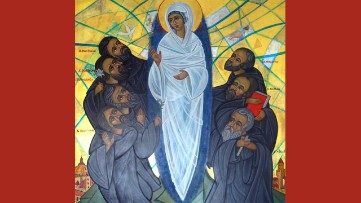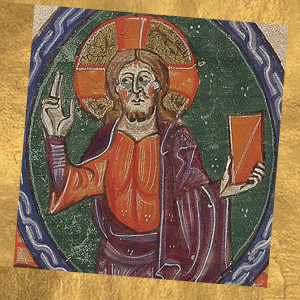Sts. Seven Fonders of the Order of the Servants of Mary among whom St. Alessio Falconieri

Leaving the city
13th century Florence. Seven merchants, members of a secular group of faithful devoted to the Blessed Virgin (the "Company of Servants of Mary" or "Laudesi"), decided to dedicate themselves to a life of penance, contemplation and service to Mary. Their choice was certainly influenced by the two great Mendicant Orders of the time, the Franciscans and Dominicans, as well as by the experience of the Camaldolese, Vallombrosians and Cluniac Monks, already present in those lands, and of penitential groups such as those of Saint Augustine and Mount Carmel, or of the lay Brothers and Sisters of Penance.
These were the Seven: Bonfilius Monaldi, leader of the secular group and of the future community, Bonajunta Manetti, future prior between 1256 and 1257, Manettus dell’Antella, creator of the first foundations in France, Amidius Amidei, central figure of the group, Sosthenes Sostegni, Hugo Uguccione, and Alexis Falconieri .
In the year 1233, while Florence was increasingly having to deal with fratricidal conflicts, the Seven abandoned their commercial activities, left their homes and distributed the goods among the poor.
Gray robes and cloaks
In September 1233 when the Seven began their new life of prayer and penance on the outskirts of the city, Iacopo da Poggibonsi, chaplain of the Laudesi and their spiritual director, had them wear the clothing of the "Brothers of Penance": a cloak and a gray wool tunic. The small community spent the day praying, working and begging in the streets of the city. Their life was withdrawn, austere and solitary, but many troubled and anguished people turned to them, always receiving consolation and advice. Most of these were struck by the fact that these Seven once wealthy merchants had voluntarily reduced themselves into poverty. This encouraged the spread of the fame of their holiness and many people begin to ask to become part of their community.
Birth of the Order
The insistent and numerous requests led them to start an Order expressly dedicated to Our Lady, called the Order of Servants of Mary. In 1234, Bishop Ardingo Foraboschi gave them land on the summit of Monte Senario, about 18 km from Florence. Initially they lived in simple huts and later built a small church dedicated to Mary on the ruins of an ancient castle. In 1239, following a visit by the Papal Legate, Cardinal Goffredo Castiglioni (the future Pope Celestine IV), they were assigned the Rule of Saint Augustine. Often, after they had been out begging, they would stop in Florence at the oratory of Santa Maria di Cafaggio. It was there that work began on building a hospice to welcome those who wanted to become part of the community.
Many vocations
Soon the Seven received permission to open other convents, even outside of Tuscany, to respond to the many vocations they continued to receive. In 1247, the Order risked being abolished when the Council of Lyons decreed the suppression of the Mendicant Orders. But Filippo Benizi, welcomed another twenty-one vocations into the Order and the future Prior General again obtained Pontifical recognition. Definitive approval came in 1304 from Pope Benedict XI. Only one of the original Seven, Alex Falconieri, was still alive at that time. He died on February 17th 1310, at almost 110 years of age. His niece, Giuliana Falconieri, also a saint, would go on to become the foundress of Mantellate Sisters. In 1888 Pope Leo XIII canonized the Seven together. In Monte Senario a single sepulcher contains their remains. Among the Servites of recent years, we remember Father David Maria Turoldo, a well-known preacher and poet.







